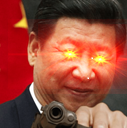Because y’all shouldn’t fall for this moralistic and anachronistic nonsense. The rentier bourgeoisie controls the servers and data centres (vulgarly called “cloud”) like they did before with the railways, the shipping infrastructure, the airlines, energy, the production and redistribution of oil and gasoline, and even other forms of communications infrastructure.
Reframing the rentier bourgeoisie as some new unique stage of development beyond capitalism (and smuggling in liberal moralisms about “fiefdoms” and “feudal lords”) is just yet another European attempt at reframing the current regressive nature of capitalism as not-capitalism in order to defend the status quo as a “democracy” at risk.
And this author doesn’t even get into Imperialism in his critique.


I feel like there has to be a fundamental misunderstanding of the social relations of feudalism to come to the idea that we have looped back around from capitalism to a “techno-feudalism” model. That relation being, Serfs living on land owned by their Lord and performing “rent in kind” in exchange for subsistence plots and housing. The product produced by the “subsistence plots” was taxed, and a large portion was given to the Lord of the Manor. The “rent in kind” took the form of Labor, which was performed on the farmlands of the Manor House. For most of Feudalism’s run, there wasn’t a monetary exchange happening between Serfs and Lords until the merchant heavy townships petitioned the monarchy for Town Charters that gave them independence outside the Feudal system in exchange for paying taxes to the monarchy.
You would have to really twist and reframe these relations to try and place “tech” inside “feudalism” since, last I checked, we do not “subsist” off the digital “land” provided to us “freely” in exchange for any form of “rent in kind”. Do I think there is a portion of people who do subsist in this way? Sure. Most of those people, however, are doing some form of drop-shipping operation if they’re not some top 1000 social media presence. Even still, those media influencers do not make the majority of their money from the platforms they participate in, many if not all of them have to seek out external forms of monetization either through direct corporate sponsorships or their own capitalist business ventures.
More importantly, though, for us to have transitioned into a “techno-feudalist” organization of the economy, the state would have to be so far diminished that the only governing and enforcement agent with power in our daily lives would be the techno-feudalist lord. Last I checked, the state currently still exists, it still has a monopoly on violence, and these supposed techno-lords have not successfully built their own townships where they control everything within its borders. Even if they did, we have a more recent historical analogy for this in the Company Town.
Global Capital in my measurement hasn’t actually developed despite what people think. In order for there to truly be a Global Capitalist force, it would need to be elevated above state influence. However, this has clearly not happened, evident by the simple fact that all transactions that happen in the global market happen with national currencies, where their origin states have near total control over its value. What a Global Capitalist movement would want is high stability and decentralization of the currency all of their global transactions are based on, but that hasn’t manifested yet.
I say yet because I think there is clear evidence that this movement is taking place, and that there is an effort to decentralize economic transactions globally. The aim of “stability” is a futile one, since, even with a decentralized foundational currency, you are still subject to capitalism’s core contradictions. Regardless, you do not have to look hard to find the movement in question, that movement is cryptocurrency. From the Bitcoin white paper (Bitcoin.org, 2008), the first two sentences of the introduction read:
We can see the framing here already. The issue with “commerce” is that you must place your “trust” in “financial institutions”. This system, according to Satoshi, “suffers from the inherent weaknesses of the trust-based model.” The “financial institutions” in question here, are state endorsed institutions, which the state “regulates” (I use this term loosely) and thus has direct control over. Naturally, in a capitalist state, this “regulation” happens in favor of the capitalist. Long term though, states are fickle things, one year you’re a feudal monarchy, the next year you’re a peoples’ republic. Who knows what the future can bring. You could see your capitalist venture go up in smoke as weeks turn into decades, leaving your legacy in ashes and your head in a basket. This is what sits at the heart of the “weakness” of the “trust-based model”, you have to place your “trust” in the state.
So what makes the cryptocurrency market the solution to this trust problem? Well, you can find that answer in the abstract of bitcoins white paper:
Here the framing is lay bare once again. “As long as a majority of [computational] power is controlled by nodes that are not… attack[ing] the network” then “control” of the network is maintained by those with “a majority of [computational] power”. The way you gain “a majority of… power” is through expending more capital than the “attackers”, in the form of server farms. Some nation states have attempted to curtail the influence of crypto in their economic affairs, from China’s numerous regulatory crackdowns on both transactions and mining operations (Coindesk, 2021), to the SEC’s own flimsy attempts at regulation (Investopedia, 2024). Others seek to legitimize them as assets or currencies, such as Japan and Australia recognizing them as “legal property”, Brazil passing a law legalizing cryptocurrencies as payment methods, to wild extremes such as the failed experiment of Bitcoin as legal tender in El Salvador (The Tico Times, 2025), or Argentina’s Bitcoin Rental Agreements (DailyCoin, 2024). In our most recent timeline, states across the US are looking to create “Bitcoin Reserves” (CNN, 2025):
This embrace of the state and Bitcoin is not unlike the embrace of the US Dollar and the state. First, Bitcoin needs to be legitimized in the eyes of the state, then the national currency needs to be delegitimized in the eyes of its citizens. We have seen, in places like Argentina, that when there is widespread instability in domestic currency, Bitcoin sees a surge in adoption (Forbes, 2023). In the Forbes, 2023 article, and the Tico Times, 2025 article above, you’ll notice an interesting theme, which is, opposition to crypto from the IMF in the form of policy requirements. The IMF, who’s loans are issued in the form of USD, and expected to be paid back in USD, has “take[n] a strong stance against crypto” and tied their loan deal with Argentina to “creating new regulations… around the cryptocurrency industry”. In the case of El Salvador, their failed experiment with Bitcoin as legal tender comes in the wake of accepting an IMF loan which required the state to delegitimize Bitcoin as a condition of the loan.
We know that the IMF has a history of making their loans conditional pending implementation of austerity measures to liberalize and privatize the state’s economy. We know that their goal in this regard is to allow foreign (USD backed) investment to dominate and extract surplus value from the state’s citizens. However, this delegitimizing of Bitcoin, to me, illustrates the “threat” crypto plays in the world’s geopolitical economy. Crypto poses a similar threat to “dollar hegemony”, in the same way BRICS is a threat to “dollar hegemony”. It isn’t simply a defense of “dollar hegemony” it is also a defense of the statist organization of the world’s economic relations. It is a clear example of the materiality of states, and their role in the global market economy.
It is no wonder then that Argentina’s new president, Javier Milei, a self-identified anarcho-capitalist, has embraced crypto assets under his administration (ID Times, 2025). With inflation skyrocketing to nearly 300%, the citizens of Argentina have turned to cryptocurrencies to hedge their bets against the domestic currencies’ depreciation.
Anarcho-capitalists would want nothing more than to institute bitcoin or some other form of crypto asset as the backbone of a truly globalized capitalist movement. This could usher us into a kind of “techno-feudalism” environment, where the “withering state” is aided by destabilizing events that drive up the legitimacy of these crypto solutions in the eyes of everyday citizens. What would remain, is the means of producing a decentralized monopoly on violence. The way I see it, the old world monetary system is slowly engaging in combat with this decentralized monetary force.